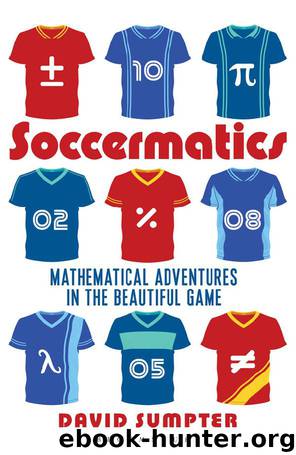Soccermatics: Mathematical Adventures in the Beautiful Game (Bloomsbury Sigma) by David Sumpter

Author:David Sumpter [Sumpter, David]
Language: eng
Format: epub
Publisher: Bloomsbury Publishing
Published: 2016-05-05T04:00:00+00:00
Pressing Power
As I mentioned earlier, big clubs are very cautious about sharing data describing the detailed movement of their players. This makes progress difficult for researchers like me, and analysis of collective team movement remains in its infancy. So far I have described a set of tools for looking at positioning and alignment, but there is so much more that could be done. Over the past ten years, several research groups, including Iain Couzin’s group in Konstanz, Charlotte Hemelrijk in Groningen, Jens Krause in Berlin, Audrey Dussutour and Guy Théraulaz in Toulouse, Irene Giardina and Andrea Cavagna in Rome, as well as Dora’s group in Oxford, Tamás’s in Budapest and my own group in Uppsala, have been decoding the rules of motion of animals. This is a Europa League of research talent, all focused on animal movement. The results have been remarkable, and we now have a good grasp of how animal ‘teams’ move together. But these results have been possible only because we have collected large quantities of data, and shared this data with one another. It should be possible to revolutionise football in the same way as we have revolutionised animal movement, but to do this we need data.
Compared with the vast array of international researchers working on animal motion, the detailed analysis of player movement remains something of a one-man show. Paul Power is lead data scientist at Prozone, and has responsibility for game intelligence. Paul has a background as a coach, working at Sunderland, where he also completed a Masters in sports science. During his studies, he read Ricardo Duarte’s ‘Sports teams as superorganisms’ article and was inspired. He wanted to use the superorganism ideas to study football, and landed himself a job at Prozone.
Working hards-on as a coach has meant that Paul wants mathematical analysis to lead to solid practical results. While I have emphasised the idea of creating a tactical map for communicating information about a match or a player, Paul aims to take analysis all the way to the training field. He wants to use match data to design training exercises. His approach goes back to the philosophy of Dutch manager Rinus Michels, who saw the manager’s primary role as creating drills that encourage a particular style of play. The manager shouldn’t have to tell the players what to do during a game if he has made them practise the most effective actions before the match starts. Paul’s aim is to use data on player movements to find out what works on the pitch, and then use this information to decide what happens on the training field.
One of the most important tactical aspects of modern football is when and how much you should press your opponents. Pressing is when the team without the ball harass the team in possession as much as possible. At least one player should hound the opposition player with the ball, and the other players should look to block potential passes. It is a truly collective action, and one in which the whole is much more than the sum of its parts.
Download
This site does not store any files on its server. We only index and link to content provided by other sites. Please contact the content providers to delete copyright contents if any and email us, we'll remove relevant links or contents immediately.
Futebol by Alex Bellos(2301)
No Hunger In Paradise by Michael Calvin(1772)
Pep Confidential by Martí Perarnau(1734)
Cristiano Ronaldo: The Biography by Guillem Balague(1515)
Sir Matt Busby by Patrick Barclay(1495)
ALEX FERGUSON My Autobiography by Alex Ferguson(1491)
The Game of Our Lives by David Goldblatt(1481)
Cyrille Regis: My Story by Cyrille Regis(1464)
No Nonsense by Joey Barton(1444)
Football's Strangest Matches by Andrew Ward(1435)
Angels with Dirty Faces by Jonathan Wilson(1395)
The Lost Boys by Ed Hawkins(1381)
Red Card by Ken Bensinger(1348)
Soccer Men: Profiles of the Rogues, Geniuses, and Neurotics Who Dominate the World's Most Popular Sport by Simon Kuper(1248)
A Season With Verona by Tim Parks(1225)
Forward: A Memoir by Abby Wambach(1210)
We Are the Damned United by Phil Rostron(1199)
Scholes : My Story (9781471125799) by Scholes Paul(1196)
50 Complete Goalkeeping Training Sessions by Hageage Tamara Browder(1184)
